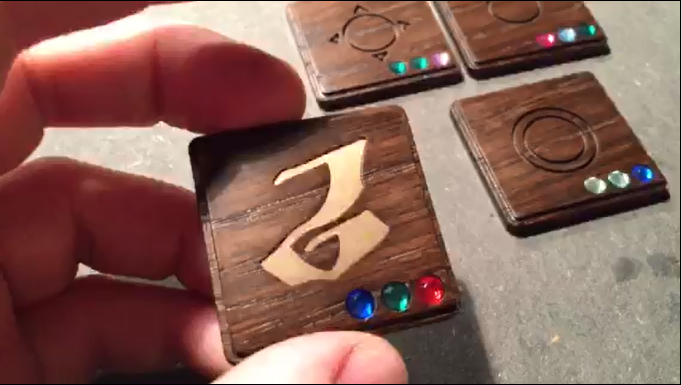We have a winner!
Tithe
by markgrafn
Not many entries this month, but a record number of comparative votes. An intriguing challenge with some very nice components made this one extra tough. Judging by the voting response, there is quite a lot to talk about concerning both the challenge and the entries. Let's get to it!
Entries are in!
A low number of entries, which gives you more time to digest them. Which of these do you think fits the bill of an "heirloom" game?
Have your votes in by the end of the 18th - and remember you can vote even if you didn't enter! VOTE HERE
Voting: Through the 18th. Votes will be through a form linked here.
Voting Format: Each person has 3 Medals (Gold, Silver, and Bronze - with values 3, 2, and 1 vote respectively) to distribute any way they choose among the GDS entries with the following restrictions:
Entrants may not assign any Medals to their own entry!
Entrants must assign all 3 Medals.
An entrant who does not assign all 3 Medals will receive a Pyrite Medal (-3 votes) as a penalty.
You know those games with "heirloom quality" pieces? Chess, Carrom, Crokinole. These games often have finely crafted game boards that owners might prominently display in their lounge, and play whilst sipping sherry and ruminating on Descartes.
What about a more "designer" game that would appeal to the sherry-sippers with teak furniture?
Just so happens that longtime BGDF member Kris (Questccg) has crafted just such a game component. Feast your eyes:

Quality wood, carved with symbols, and embedded with Swarovski crystals.
Your challenge this month is to create a pitch for a game that uses these heirloom quality tiles as the main focus. Regardless of other componenents, they should be of similar quality and the game should feel like a game that one would display in their lounge.
My suggestions are to use an abstracted medieval theme like many chess sets, or similarly 'cultured' themes. But that's only a suggestion.
The details:
Theme: Something timeless, 'cultured' feeling but no concrete restriction.
Mechanic: no restriction
Component restriction: Uses the fancy wooden tiles with coloured gems embedded in them.
Word Limit: Standard 500 word limit. Remember this is a pitch, so focus on selling and summarising more than explaining every detail
Voting: Award a Gold, Silver, and Bronze (worth 3,2, and 1 points respectively) Medals to your three favorite entries. Any entrant that does not award all three Medals will receive a Pyrite Medal (that's "Fool's Gold") worth -3 votes!
When submitting your entry: PLEASE USE THE FORM LINKED HERE.
Submissions: Monday the 2nd through Monday the 9th
Voting: Through the 16th. Votes will be through a form (link posted after submission period is ended).
Voting Format: Each person has 3 Medals (Gold, Silver, and Bronze - with values 3, 2, and 1 vote respectively) to distribute any way they choose among the GDS entries with the following restrictions:
Entrants may not assign any Medals to their own entry!
Entrants must assign all 3 Medals.
An entrant who does not assign all 3 Medals will receive a Pyrite Medal (-3 votes) as a penalty.
Comments or Questions: Comments and questions about this Challenge are handled on the Comments Thread
CRITIQUES: After voting has closed the entries will be posted for comments and critiques. Post constructive critiques and commentary about the entries to this Challenge in the Critiques Thread.
GDS Details: For more details on how these Game Design Showdown Challenges work, visit the GDS Wiki Page.
Enjoy, and good luck!
-Rich and Mindspike




Eagle Eye
The object of the game is to score points by spotting the non-matching tile.
Equipment
25 pairs of tiles. Each pair is unique in terms of its arrangement of colored gems and the central symbol.
Shields for each player
One velvet bag for the tiles
A velvet cover
Scoring tokens and penalty tokens.
Play
The starting player takes the tiles from the bag, puts them behind the shield and finds 5 pairs and one non matching tile. These are mixed and the velvet cover is put over the token. Then the cover and shield are removed. The first player to spot the unique tile gets a point. If a player picks the wrong tile, they receive a penalty token and may not guess again for that turn.
Once a player has spotted the unique tile (or if no player has done so within 3 minutes) all the tiles are placed back in the bag and they are passed to the player to the left of the starting player who then repeats what the starting player has done.
Once the bag goes back to the original starring player, that player adds 2 more matching tiles to the set up and play proceeds as before. On this round the player who spots the tile gets 2 points. Each subsequent round, the number of tiles goes up by 2 and the point value for spotting the unique tile goes up by one.
A player who accumulates 3 penalty tokens is out of the game, but they get to keep their score.
If the choosing player takes more than 4 minutes to set up, they get a penalty token.
The game ends when
(1) Only one player is remaining
or
(2) One player reaches 25 points